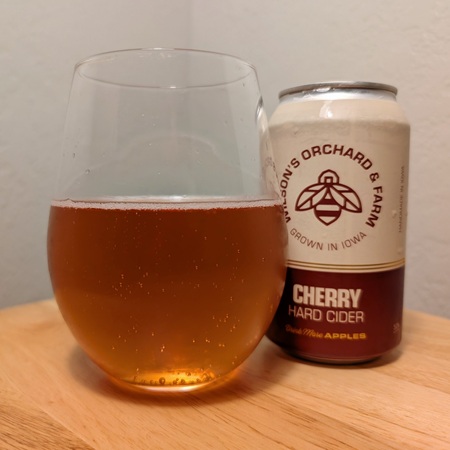What we’re drinking: Cherry Hard Cider

ABV: 5.0%
Who Brews It: Wilson’s Orchard & Farm
Where you can find it: Most grocery and liquor stores (Hy-Vee, Fareway, etc.)
Expected Price: $10.99 for a 4 pack of 12 oz. cans
We typically cover beers here at the Frosted Glass, but we’re changing things up a bit this time and covering a cider. With the fall weather setting in, ciders are becoming more prevalent on brewery menus. Still, despite being featured at craft breweries and commonly served in bottles and cans, cider is actually more similar to wine than beer. For our feature cider, we’ll be tasting a great cherry cider from Wilson’s Orchard.
Although it was formally called Cherry Crush, Wilson’s Orchard now refers to this cider as simply “Cherry”. It is not a spiced or mulled cider, so it is best kept refrigerated or chilled until tasting. Upon your first sip, you’ll taste a semi-sweet apple that quickly fades to a tart cherry. It maintains a body that tastes sweet without feeling sugary or overbearingly sweet. Overall, the taste is very light, and there is minimal aftertaste. The coloration when poured into a glass is like a rosé wine, trending towards an orange-pink when held up to light. If the cider is in a dark environment, it can look similar to a red lager. The drink has very low carbonation and a minimal to non-existent head when first poured. The cherry flavor strikes a good balance between a light, sweet summer cider and a traditional fall cider.
What Makes Cider Unique?
The key difference between a cider and a beer lies in the primary ingredients. While a beer is brewed from a malted grain (think barley) and supplemented with hops and yeast, a cider is made from fermenting pressed fruit juice. Traditionally, and still most commonly today, this fruit has been apples. Even when a cider is advertised as a different fruit, such as this cherry cider or a pear or peach cider, you’ll typically find that the featured fruit is blended with an apple base. Because of the abundance of fruit used in cider, they have a higher sugar content than beer, while beers have more carbohydrates due to their grain base.
Additionally, while making beer is called brewing, the correct term for making cider is fermenting. Fermenting is a simpler process than brewing, so the distinction in cider flavors occupies a narrower band than beer. It’s difficult to modify the taste of a cider without changing the apples themselves, but purists will argue that this allows the quality of a harvest to shine through. Modern cider brewing (post-2000) saw the creation of dry-hopped ciders, which occupy a middle ground between beer and cider. Dry hopping a cider occurs when hops are added after the cider is initially fermented. This diminishes the traditional sweetness associated with cider by replacing it with citrus or floral highlights. These highlights tend to give dry-hopped ciders a more potent aftertaste than a regular cider.
To read the remainder of this premium article and other premium articles in their entirety, pick up the Julien’s Journal October 2025 issue. Single issues are available in print for free at area newsstands, or you can click here to read the entire article for free in the digital version of the magazine.
Read Julien’s Journal, CHOICES For Fifty Plus and Tri-State Home TRENDS from the Comfort of Your Home!
Click to subscribe or call 563.557.7571 to subscribe for convenient delivery to your home or business by mail.


Comment here